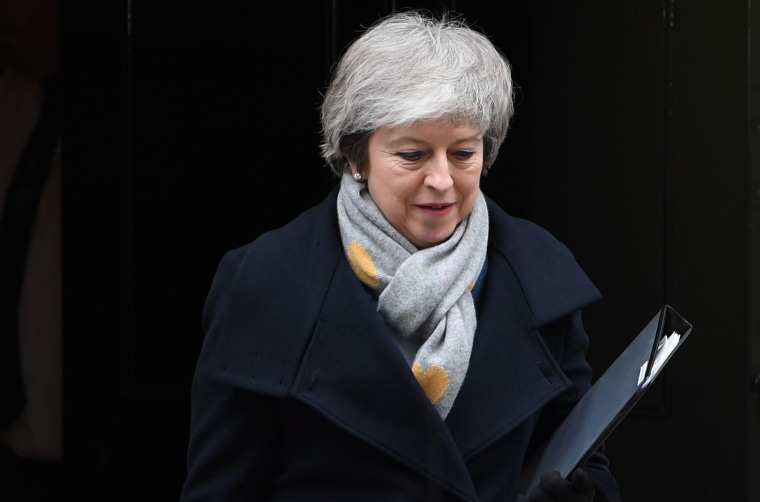The U.K.’s political mood in 2019 — much like that in the U.S. — is not one of quiet compromise. Which is why, even though the eventual consequences for our nation could be catastrophic, the compromise Brexit deal went down in ignominious flames on Tuesday but Conservative Prime Minister Theresa May nonetheless survived a no-confidence vote on Wednesday.
But let’s back up to the origins of the end of the world as Britons know it.
In the summer of 2016, the United Kingdom voted to make a huge change and leave the European Union. This would, fed-up citizens were promised, make the U.K. richer, significantly reduce immigration, restore to the U.K. control over its own laws and — best of all — serve a massive “screw you” to the British establishment.
Buoyed up by these populist ideas and sick of going years without pay raises or government spending on schools, hospitals, roads, community centers and the like, huge swaths of the country went along with idea, ignored the leaders of every major political party and voted against the wishes of a supposedly out-of-touch elite.
The U.K. thus voted Leave to take back control of (as they saw it) their country — and the 52 percent who voted in that way were, at first, jubilant.
What’s followed, though, has felt more like a two-and-a-half year hangover than anything to celebrate. What was made to sound simple turns out to be massively complicated; what we thought could be quick is painfully slow. And despite voting in favor of more control, Britain’s political system has never looked more chaotic.
Theresa May, who took the prime minister job shortly after the Brexit vote, has spent her last few years painstakingly putting together what she thought would work as a compromise deal, allowing for an orderly withdrawal from the E.U. and preventing as much chaos as possible while hewing to the reality that the members of the E.U. are under no obligation to abide by the promises that Leave campaigners made voters.
May’s deal would, she hoped, keep trade flowing between the U.K. and the E.U. — essential for an island nation which imports much of its food, medicine and raw materials — while also leaving the union initially designed to eliminate much government interference in those trade flows.
The deal she designed would eventually give the U.K. back control over its immigration policy and borders, while giving U.K. citizens currently living elsewhere in the E.U. the right to stay there, and vice-versa. It also gave both parties enough time for a permanent trade deal to be negotiated — referred to as the “transition period” — with a fallback plan to avoid disaster (the “backstop”) if those talks failed.
May’s plan was (as far as Brexit plans go, as the whole idea is now broadly thought to be a bad idea for the U.K. in general) sensible, worked as a compromise and, on paper, delivered a lot of what Brexiteers said they voted for.
And when our lawmakers voted on it on Tuesday evening, it went down to a record-breaking defeat, by 230 –—the single greatest ever margin of loss.
Leading politicians in the years since the Brexit vote have toured the country attending protests or appearing on talk shows, telling the public that Brexit can be totally easy, that a better deal can be negotiated (though the E.U. leaders have said unequivocally that it cannot), that the U.K. can get exactly everything that it wants from the E.U. while giving up precisely nothing. Voters can’t be blamed for believing them.
Elsewhere — spotting a brewing disaster — a counter-movement emerged trying to reverse the result of the 2016 vote (hardly an alien idea to an American audience) and prevent Brexit from happening at all, based on it being sold to their fellow countrymen on a false promise.
This movement has a good deal of popular and parliamentary support, and would in most scenarios rely on a second referendum, giving voters the option to cancel Brexit altogether.
Between these two groups, there is no room for compromise — which leaves a third, establishment tribe somewhere in the middle, unable to get the support to get anything done.
The U.K., then, is stuck in a three-way split: Some people want to leave the E.U. without a deal, and face the consequences of that; some people want to stop Brexit entirely, even if doing so risks a populist backlash; and some want to listen to the voters of 2016 and leave under any deal, even if that’s a messy compromise that nobody loves.
None of them have enough votes to get their way, and none of them seem willing to shift. In politics-as-usual, that would just mean annoying paralysis.
But here’s where Brexit is different from politics-as-usual: If the U.K. doesn’t do something in the next 72 days, it leaves the E.U. without a deal anyway. Preventing that requires action.
Politically, the U.K. is facing the equivalent of three people locked in a room with a time-bomb. One insists cutting the red wire is the only way to survive. Another screams that it must be blue. And the third is perfectly happy to let the bomb to go off.
That’s Britain, the day after the biggest parliamentary defeat in our history. We voted, narrowly, for a campaign to “take back control” and now we’ve never looked less in control. We’ve got 10 weeks to find some sort of way out of this mess or face pretty significant economic consequences. And nobody has a plan other than shouting at one another.





